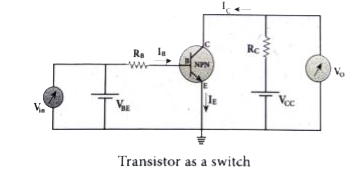Transistor functions as a switch. Explain.Solution in Tamil
Video Solution
Text Solution
The transistor in saturation and cut-off regions functions like an electronic switch that helps to turn ON or OFF a given circuit by a small control signal।

Presence of de source at the input (saturation region): When a high input voltage (V। = +5V) is applied, the base current (I−B) increases and in turn increases the collector current। The transistor will move into the saturation region (turned ON)। The increase in collector current (IC) increases the voltage drop across R, thereby lowering the output voltage, close to zero। The transistor acts like a closed switch and is equivalent to ON condition।
Absence of de source at the input (cut-off region):
A low input voltage (V∈=OV), decreases the base current (1B) and in turn decreases the collector current (1C)। The transistor will move into the cut-off region (turned OFF)। The decrease in collector current (1C) decreases the drop across Rc, thereby increasing the output voltage, close to +5 V। The transistor acts as an open switch which is considered as the OFF condition। It is manifested that, a high input gives a low output and a low input gives a high output। In addition, we can say that the output voltage is opposite to the applied input voltage। Therefore, a transistor can be used as an inverter in computer logic circuitry
|
Similar Questions
ट्रान्जिस्टर का स्विच की भाँति उपयोग समझाइए।
View SolutionTransistor functions as a switch. Explain.
View SolutionExplain briefly, the action of a transistor as a switch.
View SolutionWith a neat circuit diagram, explain the working of an npn transistor in CE node as a switch .
View SolutionExplain, how a CE transistor acts as a switch.
View SolutionTransistor functions as a switch. Explain.
View SolutionCharacteristics OF Transistor|| Transconductance|| Transistor as an Amplifier|| Transistor as a Switch
View Solution
